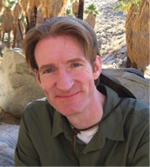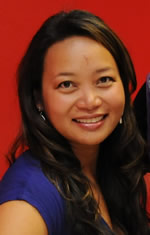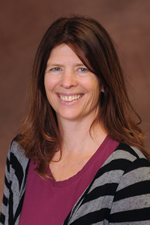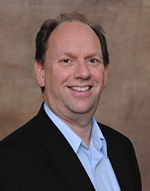
Since its formation in November 2012 by President Kuncl, the Task Force on Online Learning has been diligently working on initiatives related to the infusion of technology in teaching and learning. The Task Force has centered its efforts on the promotion of online, hybrid, and flipped teaching formats. In December 2014, a call for faculty proposals centered around flipped or hybrid course development, fully online course construction, or the integration of other types of subject specific technology was distributed. Below are this year's 8 faculty projects being sponsored by the Task Force on Online Learning.

Dr. Eric Hill got his BA in Physics from Carleton College in 1994 and his PhD from the University of Minnesota in 2001, with a focus in Condensed Matter Physics and a minor emphasis in Space Physics. His thesis work, done under Eric Ganz, used scanning tunneling microscopy to investigate atomic-scale dynamics and structures relevant to the semiconductor industry. His teaching mentor was Ken Hellar, who's active in the Physics Education Research community. After serving as a visiting professor at St. Olaf College, Eric joined the University of Redlands' Physics department in 2001. Since that time, he's taught courses in the Johnston program, the Proudian program, and the First Year Seminar program, as well as all of the physics department's regularly-offered courses aside from astronomy. He was named the Mortarboard Professor of the Year for 2008. Within faculty governance, he's served on the college's Curriculum Committee and the university's Educational Assessment Committee; he's currently serving on the college's Embedded Speaking Experience task force. In 2012 he helped establish the University's Engineering Combined-Degree partnerships, and he serves as its Liaison / Advisor. He is also a member of the Spatial Studies Advisory Committee and is completing a stint as physics-department Chair. As an experimentalist (and owner of an old house), he's a firm believer in use the right tool for the job." For his classes, that means a variety of instructional tools and modes.
Project Summary:
Nationally, a significant fraction of physics graduates go into engineering; either they directly find employment in positions that are traditionally associated with engineering, they enroll in engineering graduate programs, or they go on to earn an engineering bachelors as part of an Engineering Combined-Degree option, like the one we introduced in 2012. But at liberal arts colleges, physics students get little exposure to the diverse fields of engineering, so they aren’t well informed about their options. The Task Force for Online Learning’s grant helps address that problem at Redlands. The grant supports a May-Term Survey of Engineering course, which uses a hybrid instructional mode to connect Redlands students with engineers – both academic and professional, here and across the country. While the students are here at Redlands, engineering faculty at Manhattan College in New York will provide online content and will host live video conferences to teach our students about chemical, civil, electrical, environmental, and mechanical engineering. Meanwhile, the Redlands instructor will lead the students through laboratory experiments here, taking them on field trips to research labs at UC-Riverside, and bringing in professional engineers from around the region. This May’s offering is a pilot for a possible long-term collaboration between Redlands and Manhattan; the grant helps the collaboration over the development hump. Once the resources are developed and contacts are made this year, the course could be more easily offered future May’s or, given its modular structure (one per engineering sub-field) it could be reconfigured into stand-alone, one-unit modules that students could take independently during a regular semester.

Dr. Jenkins joined the faculty at the University of Redlands in the fall of 2014 and has since grown to love California’s warm winters and never-ending sunshine. After earning her B.A. in Geology from Wellesley College, Dr. Jenkins spent the next few years in the Amazon Basin learning to wield a 6-foot chainsaw, speak Spanish to native Peruvians, and turn trees into recorders of ancient climate history. In 2009, Dr. Jenkins received her Ph.D. in Earth & Ocean Sciences from Duke University. Her areas of expertise include geology, paleoclimatology, dendroclimatology, isotope geochemistry, and hydrology.
Here at Redlands, Dr. Jenkins teaches field and laboratory courses across the spectrum of the Earth Sciences from Natural Disasters to Geology to Oceanography. When she isn’t teaching, Dr. Jenkins can be found traipsing through the heat of the Amazon rainforest, the cool mists of the Andes Mountains, and the rugged terrain of California’s transverse ranges. Her current research interests include tree rings and extreme drought in Amazonia, spatio-temporal patterns of water distribution, quality, and scarcity in southern California, deforestation and carbon budget estimates over the Amazon rainforest, earthquakes and forest ecosystem growth and carbon loss, and the tectonics of the Altyn Tagh Fault on the North Tibetan Plateau.
Prior to coming to Redlands, Dr. Jenkins served on the teaching faculty in the Earth & Planetary Sciences department at Harvard University.Project Summary:
Teaching natural science in a technologically advancing world requires that our methods reach beyond the traditional computer-mouse interface. This project incorporates cutting edge 3D visualization technology and real-time augmented user interfaces to capture student wonder and enhance understanding of earth science processes.
In 2014, I built and installed an Augmented Reality Sandbox here at the University of Redlands to teach flooding hazard, erosion, watershed development, and spatial reasoning in my courses. This project will enhance the capabilities of the current Sandbox by creating new experimental code parameters (e.g. variable fluid viscosity and sandbox lithology) for the software and adding real-time video capture to the hardware. These upgrades will culminate in a new videography assignment in my earth science courses that allows students to simulate natural processes, real-time capture their experiments, and then edit this imagery to explain, quantify, and present their findings to the class through a short film. The AR Sandbox can be used to demonstrate a wide range of natural phenomena – from erosive processes and land formation (e.g. mountain building, faulting, alluvial fans) to fluid dynamics (e.g. standing waves, river capture, magma viscosity). Requiring students to design and videotape their own experiments enables them to take ownership of their learning – promoting a culture of advanced and self-motivated study.

Dr. Celine Ko is licensed clinical psychologist who received her Ph.D. from the Joint Doctoral Program in San Diego State University (SDSU) and University of CA, San Diego (UCSD) in 2006. She completed her postdoctoral research training in Jonsson Comprehensive Cancer Center in University of CA, Los Angeles (UCLA) in 2008.
Her primary area of interest and expertise is with cancer prevention and control, especially in the area of health disparities. She has experience with ethnically and culturally diverse populations through her research and clinical training. She has published in areas related to health disparities, cancer prevention, psychosocial interventions for cancer, and meditation and student well-being. Currently, Dr. Ko is collaborating with the biology and religious studies department to study the effects of meditation curriculum on students' stress and academic achievement. Her research interests in mindfulness informs her clinical work on mindfulness-based interventions.
Currently, she teaches Introduction to Psychology, Abnormal Psychology, Counseling Psychology and Health Psychology.
Project Summary:
Type of project (Select one from below): Flipped Classroom
I am interested in working towards flipping my psychology courses and I would like to pilot test some of the flipped course elements for two of the classes that I teach. Because I teach very applied courses, I think that students will find great value in being able to learn in a hands-on way when I actually meet with them; listening to the lecture online or viewing already available technology prior to the class will be a very efficient way for them to get exposure to the material.

Dr. Lisa LaSalle has been a professor in the University of Redlands Communicative Disorders department since Fall 2011. She previously taught for 18 years at the University of Wisconsin-Eau Claire. Dr. LaSalle is a speech-language pathologist certified by the American Speech-Language Hearing Association with specialty training in stuttering and fluency disorders. She has taught (under-)graduate courses and supervised student clinicians in Communication Sciences and Disorders programs for 22 years.
Dr. LaSalle’s research interests and publications involve the topics of childhood stuttering, concomitant disorders associated with stuttering, multilingual aspects of stuttering, and a fluency disorder known as cluttering. Recent publications include: LaSalle (2015), Slow speech rate effects on stuttering preschoolers with disordered phonology, Clinical Linguistics and Phonetics; LaSalle & Huffman (2014), Speech sample measures in Japanese children and adults who stutter, Speech, Language and Hearing; Wolk & LaSalle (2014), Phonological complexity in school-aged children who stutter and exhibit a language disorder, Journal of Fluency Disorders; LaSalle & Wolk (2011), Stuttering, cluttering, and phonological complexity: Case studies, Journal of Fluency Disorders.
Dr. LaSalle’s future research plans include the mapping of acoustic verification of accents based on data collected by former speech and hearing science students, and collaboration with medical professionals on the topic of adults who stutter and medications that affect dopamine and GABA neurotransmitters. Her clinical research plans include multilingual and cross-linguistic aspects of stuttering.
At the graduate level, Dr. LaSalle teaches Fluency Disorders, Fluency Disorders Clinic, Evidence-Based Practice, and Voice Disorders, and she currently teaches Speech and Hearing Science at the undergraduate level. Dr. LaSalle has chaired three Senior Honors thesis projects, and she now plans to teach a senior capstone course based on simulated cases.
Project Summary:
In any given year, our department has approximately 50-60 seniors majoring in CDIS. Senior CDIS students currently have a choice between two capstone courses: CDIS 411 “Assessment and intervention in communicative disorders,” and CDIS 413: “Communicative disorders capstone.” This course proposal, “CDIS 413 Communicative Disorders Capstone: Simulated Cases,” is based on the need for students to understand how to integrate liberal arts and their communicative disorders knowledge into a particular case, and to learn about various cases.
Simulation technologies are effective educational tools becoming popular in various allied health professions. The premise is that students first need to learn about a background of a case in order to know what to do, then they need to learn how to do what they have planned. Finally, they need to know how to interview properly, how to administer various diagnostic instruments, etc. Finally, students in our major need to learn to work well with classmates and professionals, in order to hone those interpersonal team work skills that will benefit them in their chosen occupations, graduate school and beyond. While many allied health professions (e.g., dentistry, pharmacy, medical, nursing) have implemented simulations, we have not yet integrated simulation teaching successfully into our communication sciences and disorders curricula.
The benefits for integrating simulation teaching into our department’s curriculum include:

Dr. Conroy Reynolds received his doctoral degree from Loma Linda Marriage and Family Therapy program and is also a Board Certified Mental Health Chaplain.
His formal teaching career began eight years ago at the University of Redlands as an adjunct professor teaching Group Counseling and Life Span Development. In the summer of 2011 he began teaching full time Visiting Assistant Professor in addition to coordinating practicum experience for students in the Clinical Mental Health program.
His interest in online learning began when he enrolled at Capella University and completed an MA in Clinical Psychology in 2004. Since then he has also completed certification as an online instructor from the @one program of California Community College. He continues to explore new opportunities to enhance teaching through the integration of cutting edge technology.
He is currently a Visiting Assistant Professor and Practicum Coordinator in the Clinical Mental Health program at University of Redlands and Mental Health Chaplain at the Loma Linda University Behavioral Medicine Center.
Project Summary:
This project will focus on the use of online learning to build the capacity of the School of Education to provide quality graduate education to students who need the course but who for a variety of reasons may not be able to take it in class. In addition it will provide a model that will enable school administrators and faculty to integrate technology into the curriculum to meet accreditation standards. All curriculum materials created will be in alignment with the CA state standards for School and Mental Health Counselors and the accreditation requirements of WASC. The course will adhere to best practices for building online courses in creation of online content, learning activities, assignments and assessments. The project will offer policy and procedural recommendations to School of Education Administration for development of additional courses that will be comparable to courses offered in the traditional format.

Dr. Gary Scott has a Masters in Biology, a minor in mathematics, and Doctorate of Education from the Graduate School of Education & Information Studies at UCLA. He was a secondary science and mathematics teacher for over 23 years in the Los Angeles Unified School District (LAUSD). He became a secondary mathematics and science advisor for LAUSD's Urban Systemic Initiative (USI) and Urban Systemic Program (USP). As a classroom teacher and advisor he has created and presented numerous in-service workshops to teachers to improve science and mathematics teaching including developing two-week summer institutes for teachers participating in the USI and USP. He helped in the development of a Coordinated Science Program for LAUSD as part of the statewide Scope, Sequence and Coordination (SS&C) Project. In conjunction with other LAUSD teachers in the SS&C Project he wrote district-wide Coordinated Science course guidelines and descriptions that received University of California approval for laboratory science. He has participated in numerous NSF-funded teacher enhancement projects, including serving as co-principal investigator on the NSF-funded IMMEX project at the UCLA School of Medicine.
He served as a mathematics and science coordinator for Local District 7 in LAUSD and developed an integrated mathematics and science intersession program for middle school students. He left LAUSD to become an assistant professor of clinical education in the Rossier School of Education at USC. Currently he is a Visiting Professor of Education at the University of Redlands.
His research interests are centered on applying cultural-historical theory and Reuven Feuerstein’s theory of Structural Cognitive Modifiability to the teaching and learning of mathematics and science. Based on these theoretical foundations he has developed and implemented many classroom projects and teacher professional development opportunities. Currently, he is working with local elementary schools to implement the Inventatorium. The Inventatoirum addresses the need for underrepresented minority youth to have opportunities for effective afterschool and curricular STEM focused educational programs. The Inventatorium integrates big ideas from science, technology, engineering, and mathematics in a project-based learning approach that is innovative and inspirational for students and can be implemented in formal as well as informal learning environments. Students are encouraged to invent, design, and build structures, mechanisms, and devices based on their interests and creativity. These cognitively demanding and interesting tasks, problems, design challenges, and mediation strategies promote conceptual understanding of important mathematical and scientific ideas that build emotional connections to knowledge of mathematics and science concepts. In short, the Inventatorium’s activities invoke creativity, imagery and emotion that are often absent from traditional STEM teaching and curricula in K-12 educational settings.
Project Summary:
This spatial integration proposal will better prepare prospective teachers in the School of Education to implement spatially-based tasks, problems, and engineering design challenges. In turn, these activities will help their students improve innate capacities for spatial thinking. I will assign these spatially-based tasks, problems, and projects during face-to-face-time. Text and article readings that describe the underlying concepts for these activities will be assigned for homework
Spatial integration is based on the following logic derived from emerging research on the role that spatial reasoning plays in supporting STEM success: (1) students with greater spatial reasoning abilities perform better in high school and college-level STEM courses, even when controlling for verbal and mathematical abilities; (2) spatial reasoning abilities are an important component of STEM thinking skills that lead to success in higher-level STEM courses; (3) STEM courses serve as gatekeepers for students entering many professional fields; and (4) spatial reasoning abilities may be improved through training and educational interventions. Applying research on spatial thinking interventions that have been shown to be effective with middle school and college-age students, spatial STEM integration will build prospective teachers capacity to (1) choose or create optimal external representations and use novel external representations productively in the classroom; (2) implement spatial thinking experiences for their students that effectively and efficiently support student competency, motivation and persistence.
This project will contribute to the University of Redlands goal of infusing spatial thinking across the curriculum in the following ways:

Dr. Greg Thorson serves as both the Director of the Public Policy program and as the Ken and Lynn Hall Endowed Chair of Public Policy at the University of Redlands. He received his Ph.D. from the University of California at Riverside (1995). Professor Thorson teaches courses on education policy, health care policy, the policy process, quantitative methods, and other courses in American politics.
Professor Thorson’s research focuses on education policy. His current work examines the effects of economic inequality on international test scores, the effects that No Child Left Behind sanctions have had on California schools, the effectiveness of charter schools, and the changes in American public opinion towards K-12 schools.
His research has been published in some of the most prestigious journals in the field, including the Journal of Politics, Political Research Quarterly, Congress and the Presidency, The International Journal of Forecasting, and Educational Leadership. Professor Thorson has co-authored more than a dozen published papers with his undergraduate students.
Professor Thorson has also worked extensively with business groups, nonprofits, and local governments. He has worked with groups of small employers to form a health care purchasing alliance and assisted local government officials in a variety of planning initiatives. He has testified in state legislatures six times on a variety of health care and education policy initiatives.
Professor Thorson joined the University of Redlands faculty in 2008.
Project Summary:
In this project, I will use my introductory course in American Politics (POLI 111) to examine some basic questions about the efficacy of flipping the classroom. Specifically, I'm interested in knowing a) what students believe are the advantages and disadvantages of flipping the classroom, and b) whether students prefer the flipped classroom more or less than traditional teaching methods.
I intend to divide the class into three equal sections. I will administer the first third of my class in a traditional manner. The class will meet twice each week for 80 minutes per session. During this first section, I will teach students about the origins of our constitution and federalism. The sessions typically involve a mix of lecture and discussion.
During the second third of the class, I will flip the classroom to teach about civil liberties, civil rights, and Congress. During these four weeks, I will reduce the classroom meetings to just one 80 minute session per week and provide all of the lecture content via streaming video on the course Moodle site. The weekly face-to-face session will be limited to interactive reviews of the material, discussions and critiques, and discussion of current events. No new lecture content will be introduced in class.
Finally, for the final third of the class, I will return to the format of meeting twice per week to teach about the presidency and the judiciary using a combination of traditional lecture and discussion activities.
At the completion of the course, I will administer a specially designed supplemental teaching evaluation to determine students attitudes about flipping the course vs. traditional teaching methods.
I hope to write up the results of this field experiment and present them at an upcoming Educause meeting.
Dr. Tamara Veenstra has been a member of the Mathematics Department at University of Redlands since 2001. She completed her undergraduate work at University of North Carolina at Chapel Hill and received her Ph.D. in mathematics from Dartmouth College. Her mathematical background is in number theory and she is especially interested in the applications of number theory to cryptography. She also has interests in the mathematics of origami and cryptography. She teaches a wide variety of courses in the mathematics department including lots of Calculus, Number Theory, Abstract Algebra, Linear Algebra, Geometry and her favorite course, a May term course in Mathematical Cryptography.
Project Summary:
For many years the mathematics department has struggled with the rising costs of Calculus textbooks (most over $200) and the classroom technology (the software package Maple) and finding appropriate ways to keep students actively engaged with Calculus. My project aims to search for solutions all of these issues in my two sections of Calculus 1 in Fall 2015. The first part of my project will be to pilot a new online textbook, Active Calculus by Matt Boelkins of Grand Valley State University. The author has generously made this textbook available for free in a pdf format or students can order an extremely inexpensive (<$20) hardcopy. A second part of this project will be to work with my colleagues to convert many of our Calculus activities from the proprietary (and expensive) software package of Maple which students can only use on computers in the mathematics classrooms to open source alternatives such as Sage and Geogebra that are freely available. Because the new textbook is designed to be read (actively!) outside of class another major component to my project is to develop materials to flip the classroom. I will be creating supplemental screencasts/videos and mathematical exercises using the open source WeBWorK program (an online software tool developed by the Mathematical Association of America to create mathematical exercises where students can receive immediate feedback on their understanding of the material). These activities will support students in their comprehension of the reading and development of basic calculus skills, so that class time can be used for more advanced and complex problem solving activities as well as focusing on more challenging conceptual topics.